Are you wondering how to create a newsletter? Creating an email newsletter is a great way to get your message across, whether you’re a blogger and want to give your readers regular updates or you’re a business trying to generate more leads. Sending a newsletter allows you to get your message straight into the inbox of the people you want to see it. But if you’ve never created an email newsletter before, it can be intimidating. But, don’t worry.
In this article, we’ll show you how to set up an email newsletter in 10 easy steps.
Let’s get started.
1. Create a Plan and Set Goals for Your Newsletter
Before you start creating a newsletter, you first need to create a plan and set goals. Without a plan, your newsletter will be disorganized. Plus, you shouldn’t send out a newsletter without any reasoning or goals behind it. An email newsletter should serve a purpose for your business or blog, such as to:
- Drive more traffic to your website
- Increase engagement and shares
- Promote your product or services
- Build a loyal following
- Generate sales
Decide what the goal of your newsletter will be and craft your newsletter with that goal in mind. Having a goal for your newsletter will make it more effective.
After deciding the goal of your newsletter, come up with a plan. A newsletter plan consists of:
- What content will you send
- When and how often will you send out your newsletters
- Who will you send your newsletters to
Planning out the content you send will make it much easier for you to manage. Instead of having to come up with something to say on the spot, you can refer to the plan you created.
2. Choose an Email Marketing Service
Next, you need to choose an email marketing service. Wondering why you can’t just use Gmail or Outlook? If you’re just sending out a newsletter to a few family members and friends, Gmail is fine. But if you want to send your newsletter in bulk to potential clients and email subscribers, you need a better solution. In order to send a professional-looking email that doesn’t look like spam, you need to go with an email marketing service.
A good email marketing service will provide pre-designed email templates to give your newsletter a professional look in an instant, allow you to easily import your contact list, offer personalization and automation features, and increase the chances that your newsletter is successfully delivered and read.
Luckily, there are a number of affordable, easy-to-use email marketing services on the market. Let’s go over a couple of our top choices for the best email marketing services.
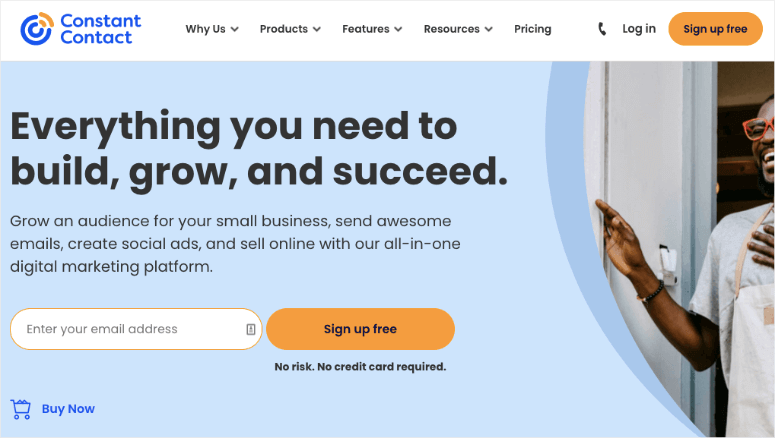
Constant Contact is the most popular email marketing service for small businesses. They offer 100s beautifully designed templates and with their user-friendly drag and drop editor, you can easily customize them to fit your brand and your needs. Plus, all of their templates are mobile-responsive, so they look great on any device.
Constant Contact also offers a number of email marketing automation features such as automatic welcome emails for new subscribers, trigger email series based on where a user clicks, segment contacts for improved personalization, automatically resend emails to non-openers, and more.
With Constant Contact, you can rest assured that you’ll always get the help that you need with their stellar customer support that includes live chat, email, discussion forums, and a resource library.
Constant Contact also offers a free 60-day trial, more than any other email marketing service. After the free trial ends, their paid plans start at $12/month for up to 500 subscribers.
Get started with Constant Contact today.
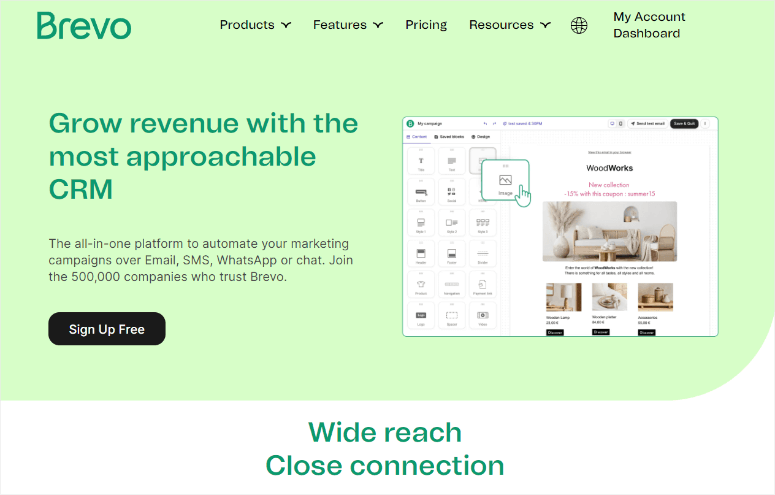
Brevo in another amazing email marketing service that’s built with simplicity in mind. Without any technical experience, you can easily set up a professional email newsletter in no time. SendinBlue offers a free responsive template gallery as well as an easy-to-use drag and drop editor to fully customize your template.
They also offer 8 automation workflows right out of the box such as welcome emails, abandoned cart reminders, and more. Other features include email personalization, landing page builder, send time optimization, and much more.
With SendinBlue, their pricing is based on the number of emails you send, not on the size of your email list like other email marketing services. With their free plan, you can send up to 300 emails per day. Their paid plans start out at $25/month for 20K emails per month.
3. Create a Branded Newsletter
After you’ve chosen the best email marketing service for your needs, it’s time to start creating your newsletter.
The first step is to choose a newsletter template. Most email marketing services like Constant Contact will provide numerous great-looking email templates. Choose a template that’s specifically designed for newsletters, such as the first 2 in the image below.
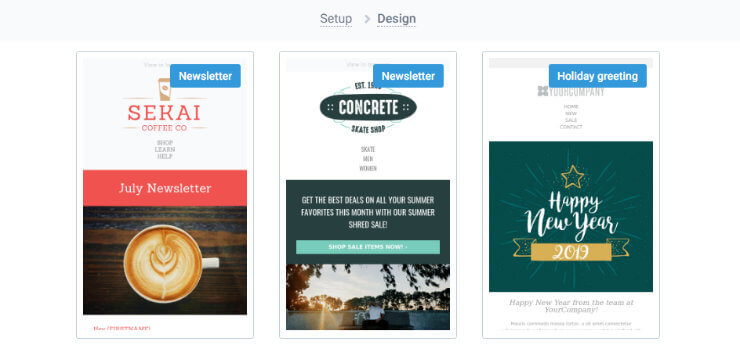
Choosing a template that’s designed specifically for your needs and one that fits with your brand will eliminate the amount of work you have to do to create your newsletter.
If you can’t find a template that matches your color scheme or type of business, don’t worry. Using the drag and drop editor, you can change the colors, insert your own images, upload your logo, and more to make the template completely customized.
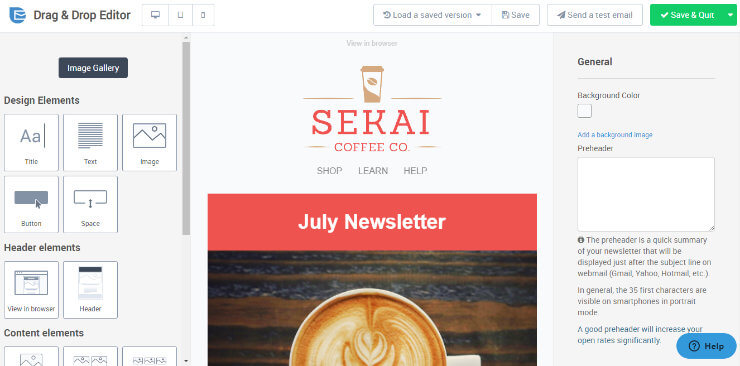
It’s important to customize your newsletter so that your readers can easily recognize that the email is from you.
Don’t go overboard though by adding too many images or anything flashy. Your newsletter should be easy to read and the design shouldn’t be distracting from the content.
4. Add Newsletter Body Content
After you’ve got your newsletter template looking how you want it to, it’s time to add the body content. The body content is what you’ll write in the newsletter. Most email newsletter templates will come with some pre-written body content. Simply erase the pre-written content and replace it with your own.
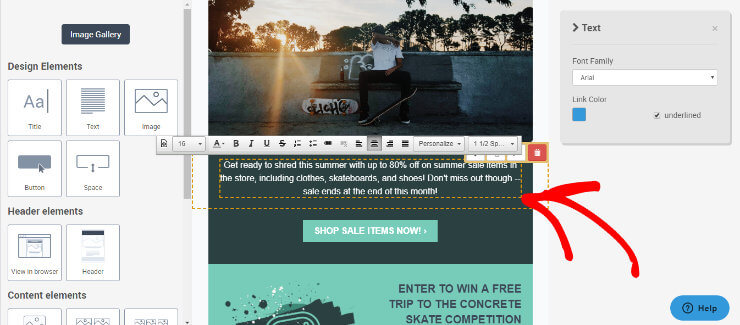
Don’t write huge blocks of paragraphs, most users won’t want to read that. Instead, write in a scannable way — smaller paragraphs with some blank space separating them. Most email newsletter templates are already designed for the best readability so stick to the formatting of your template.
Remember to add a call-to-action as well. It’s important to let your readers know what to do next after reading your newsletter. Do you want them to click on a link? Visit your website? Share your newest blog post? Your readers will be more likely to take your desired action if you ask them to.
5. Pick Your Subject Line and Sender Name
Next, you need to pick your subject line. The subject line is a very important part of your newsletter. After all, it’s the first thing users will see in their inbox. Your subject line has to be interesting enough to make them want to click on your email and read it. In fact, according to statistics, 35% of email recipients open emails based on the subject line alone.
To come up with an eye-catching subject line for your newsletter, here are some best practices for you to follow:
- Keep your subject lines under 50 characters so it doesn’t get cut off on the screen.
- Your email subject line should give readers an idea about what’s inside your newsletter.
- Don’t write your email subject line in ALL CAPS and don’t overuse exclamation points!!!
- Create a sense of urgency or curiosity with your email subject line.
- Make readers feel special, for instance “A special gift for you”.
- Add personalization. Adding the recipients name to the email subject line increases open rates.
Try coming up with 10 email subject line ideas for every newsletter you write so you’re able to find the most enticing one that will make readers curious enough to click.
You also need to choose your sender name. If recipients see that the sender name is something like business@professionalservices.com, they’ll be too intimidated or uninterested to click on your newsletter. Instead, it’s best to use your personal name and your business name such as “Bob at Boats Inc.” or something similar. You want your recipient to recognize who the email is coming from and be comfortable opening it.
6. Add Personalization to Your Email Newsletter
As we briefly mentioned earlier, adding personalization to your newsletter is important. Personalized email messages improve click-through rates by an average of 14% and conversions by 10%.
There are a number of ways you can personalize your newsletters to your recipients. The first is to address them by name in the email subject line or within the email. You can also add other personalization tokens such as their location. Most email marketing services provide personalization tokens built in. For instance, in the template example below, the recipients name is automatically added to the email.
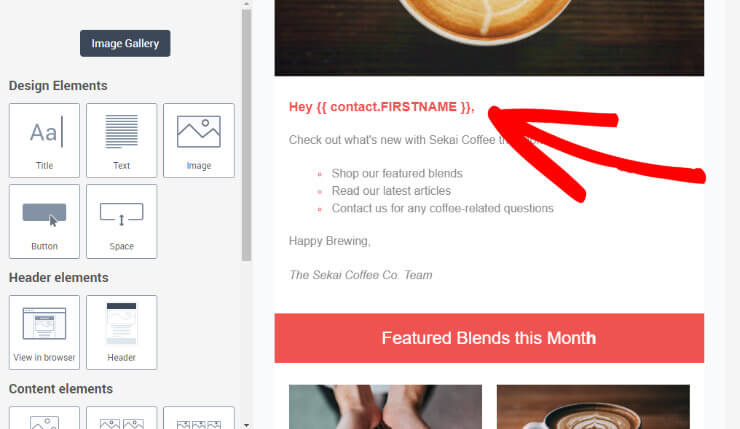
You can also segment your email list in order to send certain messages to certain subscribers. Email segmentation allows you to identify and group contacts based on different criteria so you can deliver more relevant newsletters to them.
For instance, you can segment your list based on location. So, if your newsletter is announcing a local event, you can send the email to only your subscribers who are in the area.
You can also segment your list based on gender, occupation, interests, new subscribers, purchase history, and much more.
When your newsletter looks like it was made especially for the recipient, they’ll be more likely to open your email, read your newsletter, and take action.
7. Make Sure You’re Legally Compliant
Another important step in creating a newsletter is to make sure you’re legally compliant. Did you know that there are laws in place for email marketing? There are 2 main laws you need to be concerned about, we’ll go over each below:
CAN-SPAM:
The CAN-SPAM Act was signed into law in 2003 and gives recipients the right to have you stop emailing them. To abide by the CAN-SPAM Act, you need to have a footer in your email newsletter with your email address and the address of your business. You also need to provide recipients an easy way to unsubscribe from your emails. Most email marketing services have this built in, just simply enter in your information and you’re set.
GDPR:
GDPR is a similar law passed in Europe in 2018. This law requires that email marketers only send newsletters to people who have opted into receiving them. This means when you’re collecting emails on your website, you can not automatically check the “opt in” box for users. Users have to manually check this box themselves.
If you’re abiding by these laws, you’re good to go.
8. Send Your Email Newsletter
Now, it’s time to send your newsletter. Before sending your email, make sure you’re in compliance with CAN-SPAM and GDPR, check over your template to make sure everything looks right and look over your newsletter for any spelling or grammar errors.
After making sure everything is in order, hit send!
9. Track Your Newsletter Success
After you’ve sent out your first newsletter, don’t just sit back and hope for the best. Instead, track your success with the analytics reports your email marketing service provides.
In your email newsletter analytics you’ll be able to track a number of important metrics including:
- Open Rates – The number of recipients who opened your newsletter.
- Click-Through Rates – See what links in your newsletter got the most clicks.
- Unsubscribe Rates – Who’s unsubscribing from your email newsletters.
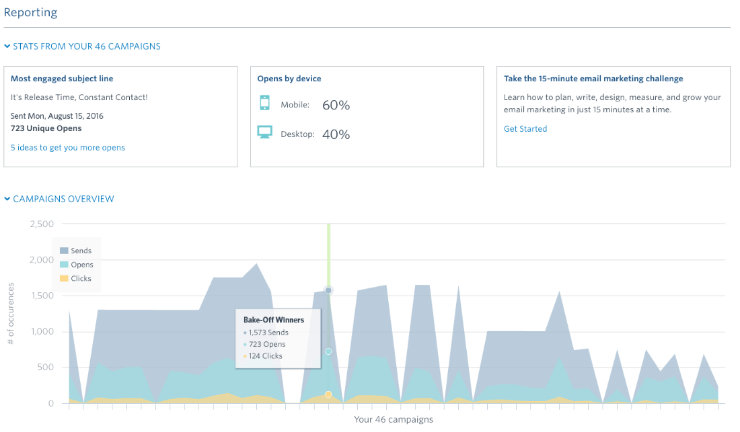
Many email marketing services will also let you perform A/B testing of your subject lines. A/B testing allows you to create an email with 2 subject lines and see which one performs better.
Analyzing this data will help you determine what’s working in your newsletters and what’s not so that you can improve the success of your newsletter next time.
10. Grow Your Email List
After creating a successful newsletter, you’ll want to be able to spread your message to even more readers. So, start growing your email list.
You can easily grow your email list using a tool like OptinMonster.
OptinMonster is the best lead generation plugin on the market. With this tool, you’re able to create great-looking email optin campaigns for your website. They provide a wide range of pre-made templates and their drag and drop builder allows you to create a customized popup in minutes without touching a line of code.
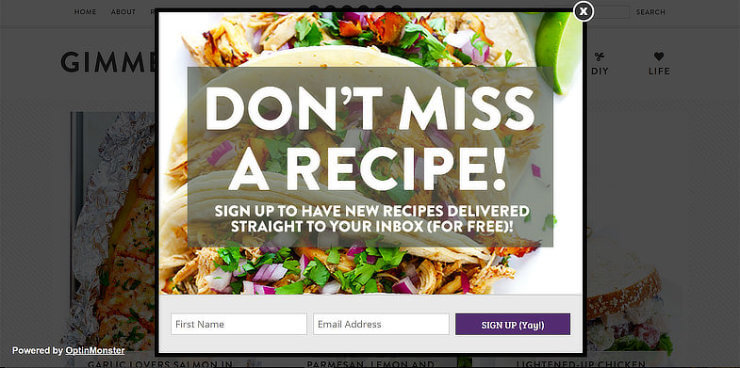
One of OptinMonster’s standout features is their exit-intent technology. Exit-intent technology is able to track when a user is about to leave your website and display a targeted message to encourage them to become a subscriber at exactly the right time. With a tool like OptinMonster, you’ll be able to explode your email list.
We hope you enjoyed this article on how to create a newsletter. With these tips, your first email newsletter is sure to be a success. If you enjoyed this article, check out our other post on Tips to Get More Email Subscribers and the best CRM software.
